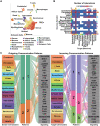High-Resolution Transcriptomic Landscape of the Human Submandibular Gland
- PMID: 36726292
- PMCID: PMC10249006
- DOI: 10.1177/00220345221147908
High-Resolution Transcriptomic Landscape of the Human Submandibular Gland
Abstract
Saliva-secreting and transporting cells are part of the complex cellular milieu of the human salivary gland, where they play important roles in normal glandular physiology and diseased states. However, comprehensive molecular characterization, particularly at single-cell resolution, is still incomplete, in part due to difficulty in procuring normal human tissues. Here, we perform an in-depth analysis of male and female adult human submandibular gland (SMG) samples by bulk RNA sequencing (RNA-seq) and examine the molecular underpinnings of the heterogeneous cell populations by single-cell (sc) RNA-seq. Our results from scRNA-seq highlight the remarkable diversity of clusters of epithelial and nonepithelial cells that reside in the SMG that is also faithfully recapitulated by deconvolution of the bulk-RNA data sets. Our analyses reveal complex transcriptomic heterogeneity within both the ductal and acinar subpopulations and identify atypical SMG cell types, such as mucoacinar cells that are unique to humans and ionocytes that have been recently described in the mouse. We use CellChat to explore ligand-receptor interactome predictions that likely mediate crucial cell-cell communications between the various cell clusters. Finally, we apply a trajectory inference method to investigate specific cellular branching points and topology that offers insights into the dynamic and complex differentiation process of the adult SMG. The data sets and the analyses herein comprise an extensive wealth of high-resolution information and a valuable resource for a deeper mechanistic understanding of human SMG biology and pathophysiology.
Keywords: gene expression; salivary glands; single-cell RNA-sequencing; transcription factors; transcriptomics.
Conflict of interest statement
The authors declared no potential conflicts of interest with respect to the research, authorship, and/or publication of this article.
Figures





References
-
- Chen M, Lin W, Gan J, Lu W, Wang M, Wang X, Yi J, Zhao Z. 2022. Transcriptomic mapping of human parotid gland at single-cell resolution. J Dent Res. 101(8):972–982. - PubMed
-
- Chenevert J, Duvvuri U, Chiosea S, Dacic S, Cieply K, Kim J, Shiwarski D, Seethala RR. 2012. DOG1: a novel marker of salivary acinar and intercalated duct differentiation. Mod Pathol. 25(7):919–929. - PubMed
Publication types
MeSH terms
Grants and funding
LinkOut - more resources
Full Text Sources
Molecular Biology Databases

